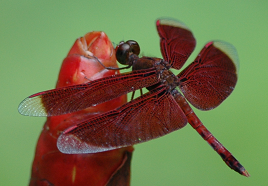
Changing the way we look at the world
Metamorphosis in insects: a challenge to evolution
Insects are fascinating creatures. Part of that fascination is the fact that many of them have a two-stage life; hatching from eggs as nymphs or larvae which then undergo a transformation to adults by the process of metamorphosis. We are all familiar with caterpillars which become butterflies.
Not so obvious are insects which start out as nymphs, such as mayflies, damselflies and dragonflies. Juvenile mayflies, damselflies and dragonflies live in water and are not able to fly but metamorphose into terrestrial flying adults.
For both terrestrial larvae and aquatic nymphs these transformations involve massive changes to their bodies.
Evolutionists like to say that nothing in biology makes sense without evolution, but they are unable to explain the origin of the many new features required to turn a larva or nymph into an adult insect.
This problem is particularly acute because there is also a genetic system to control the whole process of metamorphosis as well as the genes for two radically different body plans.
Aquatic nymphs have gills for extracting oxygen from the water and adult insects have a system of tubes called trachea for breathing in the air. The nymph does not have wings, whereas the adult has wings and is able to fly. Some like the dragonflies are among the most powerful flyers of the insect world.
Caterpillars are basically eating machines. Caterpillars have chewing mouth parts and move by crawling whereas butterflies have tube-like mouth parts for sucking up nectar and beautiful coloured wings which they use to fly from flower to flower.
When one thinks of all that goes with flying the problem is even bigger. Wings have to be efficient aerofoils and the muscles which move the wings are finely controlled.
Dragonflies are especially skilful flyers,
they are able to hover and can even fly
backwards.
The whole flight system is needed for an insect
to fly successfully. There is no way that slow
gradual evolution is possible because if one part is missing,
then the insect will not be able to fly. A creature with wings that is not able to fly because the control systems have not evolved, is not going to survive very long.
Evolutionists are also unable to show how a creature that is perfectly designed to live in water evolved a terrestrial adult stage that flies. Similarly, they are unable to show how a hypothetical ancestral caterpillar-like creature could evolve into a creature which metamorphoses into a butterfly with a radically different body plan. The best they can do is describe the complex genetic networks which control the various stages of insects which undergo metamorphosis. That these systems could evolve has to be believed it spite of the fact that there is no plausible mechanism.
It seems that the creator made these fascinating creatures to make it clear that evolution is impossible.
Insects are fascinating creatures. Part of that fascination is the fact that many of them have a two-stage life; hatching from eggs as nymphs or larvae which then undergo a transformation to adults by the process of metamorphosis. We are all familiar with caterpillars which become butterflies.
Not so obvious are insects which start out as nymphs, such as mayflies, damselflies and dragonflies. Juvenile mayflies, damselflies and dragonflies live in water and are not able to fly but metamorphose into terrestrial flying adults.
For both terrestrial larvae and aquatic nymphs these transformations involve massive changes to their bodies.
Evolutionists like to say that nothing in biology makes sense without evolution, but they are unable to explain the origin of the many new features required to turn a larva or nymph into an adult insect.
This problem is particularly acute because there is also a genetic system to control the whole process of metamorphosis as well as the genes for two radically different body plans.
Aquatic nymphs have gills for extracting oxygen from the water and adult insects have a system of tubes called trachea for breathing in the air. The nymph does not have wings, whereas the adult has wings and is able to fly. Some like the dragonflies are among the most powerful flyers of the insect world.
Caterpillars are basically eating machines. Caterpillars have chewing mouth parts and move by crawling whereas butterflies have tube-like mouth parts for sucking up nectar and beautiful coloured wings which they use to fly from flower to flower.
When one thinks of all that goes with flying the problem is even bigger. Wings have to be efficient aerofoils and the muscles which move the wings are finely controlled.
Dragonflies are especially skilful flyers,
they are able to hover and can even fly
backwards.
The whole flight system is needed for an insect
to fly successfully. There is no way that slow
gradual evolution is possible because if one part is missing,
then the insect will not be able to fly. A creature with wings that is not able to fly because the control systems have not evolved, is not going to survive very long.
Evolutionists are also unable to show how a creature that is perfectly designed to live in water evolved a terrestrial adult stage that flies. Similarly, they are unable to show how a hypothetical ancestral caterpillar-like creature could evolve into a creature which metamorphoses into a butterfly with a radically different body plan. The best they can do is describe the complex genetic networks which control the various stages of insects which undergo metamorphosis. That these systems could evolve has to be believed it spite of the fact that there is no plausible mechanism.
It seems that the creator made these fascinating creatures to make it clear that evolution is impossible.


